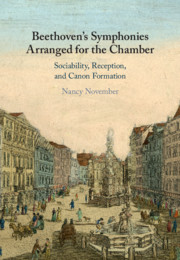
-
Select format
-
- Publisher:
- Cambridge University Press
- Publication date:
- May 2021
- June 2021
- ISBN:
- 9781108924207
- 9781108831758
- 9781108927116
- Dimensions:
- (244 x 170 mm)
- Weight & Pages:
- 0.65kg, 300 Pages
- Dimensions:
- (244 x 170 mm)
- Weight & Pages:
- 0.484kg, 278 Pages
- Subjects:
- Music, Music Performance, Nineteenth-Century Music
You may already have access via personal or institutional login- Subjects:
- Music, Music Performance, Nineteenth-Century Music
Book description
Early nineteenth-century composers, publishers and writers evolved influential ideals of Beethoven's symphonies as untouchable masterpieces. Meanwhile, many and various arrangements of symphonies, principally for amateur performers, supported diverse and 'hands-on' cultivation of the same works. Now mostly forgotten, these arrangements served a vital function in nineteenth-century musical life, extending works' meanings and reach, especially to women in the home. This book places domestic music-making back into the history of the classical symphony. It investigates a largely untapped wealth of early nineteenth-century arrangements of symphonies by Beethoven - for piano, string quartet, mixed quintet and other ensembles. The study focuses on three key agents in the nineteenth-century culture of musical arrangement: arrangers, publishers and performers. It investigates significant functions of those musical arrangements in the era: sociability, reception and canon formation. The volume also explores how conceptions of Beethoven's symphonies, and their arrangement, changed across the era with changing conception of musical works.
Reviews
‘… innovative study … Recommended.’
D. Arnold Source: Choice Connect
Contents
-
Introduction
pp 1-6 -
-
- You have access
- Export citation
-
Metrics
Full text views
Full text views help Loading metrics...
Loading metrics...
* Views captured on Cambridge Core between #date#. This data will be updated every 24 hours.
Usage data cannot currently be displayed.
Accessibility standard: Unknown
Why this information is here
This section outlines the accessibility features of this content - including support for screen readers, full keyboard navigation and high-contrast display options. This may not be relevant for you.
Accessibility Information
Accessibility compliance for the PDF of this book is currently unknown and may be updated in the future.


